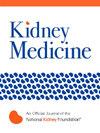Predicting Hospitalization and Related Outcomes in Advanced Chronic Kidney Disease: A Systematic Review, External Validation, and Development Study
IF 3.4
Q1 UROLOGY & NEPHROLOGY
引用次数: 0
Abstract
Rationale & Objective
Hospitalization is common in patients with advanced chronic kidney disease (CKD). Predicting hospitalization and related outcomes would be beneficial for hospitals and patients. Therefore, we aimed to (1) give an overview of current prediction models for hospitalization, length of stay, and readmission in patients with advanced CKD; (2) externally validate these models; and (3) develop a new model if no valid models were identified.
Study Design
Systematic review, development, and external validation study.
Setting & Participants
We were interested in prediction models of hospitalization, length of stay, or readmission for patients with advanced CKD. Our available development and validation data consisted of hemodialysis, peritoneal dialysis, and advanced CKD patients not receiving dialysis from a Dutch dialysis and European advanced CKD cohort.
Selection Criteria for Studies
We systematically searched PubMed. Studies had to intentionally develop, validate, or update a prediction model in adults with CKD.
Analytical Approach
We used the PROBAST for risk of bias assessment. Identified models were externally validated on model discrimination (C-statistic) and calibration (calibration plot, slope, and calibration-in-the-large). We developed a Fine-Gray model for hospitalization within 1 year in patients initiating hemodialysis, accounting for the competing risk of death.
Results
We identified 45 models in 8 studies. The majority were of low quality with a high risk of bias. Due to underreporting and population-specific predictors, we could only validate 3 models. These were poorly calibrated and had poor discrimination. Using multiple modeling strategies, an adequate new model could not be developed.
Limitations
The outcome hospitalization might be too heterogeneous, and we did not have all relevant predictors available.
Conclusions
Hospitalizations are important but difficult to predict for patients with advanced CKD. An improved prediction model should be developed, for example, using a more specific outcome (eg, cardiovascular hospitalizations) and more predictors (eg, patient-reported outcome measures).
Plain-Language Summary
Hospitalizations often occur in patients with advanced chronic kidney disease. By predicting hospitalization and related outcomes, patients can better prepare for the future and cope with their disease. Therefore, we searched existing literature for existing methods to predict hospitalizations and related outcomes. Although many algorithms exist, they are often not available for use or are not reliable. We then developed our own algorithm to predict hospitalization in the coming year. However, it also did not predict reliably. In this study, we summarize what failed in existing prediction algorithms, what we learned from predicting hospitalization ourselves, and how to proceed to allow reliable predictions of hospitalizations.
预测晚期慢性肾脏疾病的住院和相关结局:一项系统回顾、外部验证和发展研究
基本原理及目的住院治疗是晚期慢性肾脏疾病(CKD)患者的常见现象。预测住院和相关结果对医院和患者都是有益的。因此,我们的目的是(1)概述目前晚期CKD患者住院、住院时间和再入院的预测模型;(2)外部验证这些模型;(3)如果没有找到有效的模型,则开发新的模型。研究设计系统回顾、开发和外部验证研究。设置,我们对晚期CKD患者住院、住院时间或再入院的预测模型感兴趣。我们现有的开发和验证数据包括血液透析、腹膜透析和来自荷兰透析和欧洲晚期CKD队列的未接受透析的晚期CKD患者。研究选择标准我们系统地检索了PubMed。研究必须有意地开发、验证或更新成人CKD的预测模型。我们使用PROBAST进行偏倚风险评估。对已识别的模型进行模型判别(c统计量)和校准(校准图、斜率和校准-in- large)的外部验证。我们开发了一个Fine-Gray模型,用于开始血液透析的患者在1年内住院,考虑到竞争的死亡风险。结果8项研究共鉴定出45个模型。大多数是低质量的,偏倚风险高。由于漏报和特定人群的预测因素,我们只能验证3个模型。这些工具校准得很差,辨别能力也很差。使用多种建模策略,无法开发出合适的新模型。局限性:住院治疗的结果可能过于异质性,我们没有所有可用的相关预测因子。结论住院治疗对晚期CKD患者很重要,但难以预测。应当开发一种改进的预测模型,例如,使用更具体的结果(例如,心血管住院)和更多的预测因子(例如,患者报告的结果测量)。住院治疗经常发生在晚期慢性肾脏疾病患者中。通过预测住院和相关结果,患者可以更好地为未来做好准备并应对疾病。因此,我们检索了现有文献,寻找预测住院率和相关结果的现有方法。虽然存在许多算法,但它们往往无法使用或不可靠。然后,我们开发了自己的算法来预测未来一年的住院情况。然而,它也不能可靠地预测。在本研究中,我们总结了现有预测算法中失败的地方,我们从自己预测住院中吸取的教训,以及如何继续进行可靠的住院预测。
本文章由计算机程序翻译,如有差异,请以英文原文为准。
求助全文
约1分钟内获得全文
求助全文

 求助内容:
求助内容: 应助结果提醒方式:
应助结果提醒方式:


